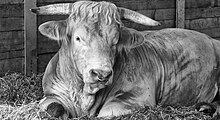Glan cattle
This article includes a list of generalreferences,butit lacks sufficient correspondinginline citations.(August 2013) |
This articleneeds additional citations forverification.(August 2013) |



Glan cattleare a traditional cattle breed particularly found in theRhineland-Palatinateregion ofGermany.At one time they were almost extinct, but today there are about 2,000 animals. Originally multipurpose, they are nowadays mainly used for beef production.
Characteristics
[edit]- Height: bulls 140–145 cm; cows 135–140 cm
- Weight: bulls 1,000–1,200 kg; cows 600–750 kg
An important breeding aim is the unicoloured yellowish fur.[1]
History
[edit]The modern type of Glan multipurpose cattle was established byDukeChristian IV, Count Palatine of Zweibrücken,through an inspection decree of 12 September 1773 that demanded the improvement of the local small red breed through usingSimmentalandBerne Mountainbulls. By 1762 the import ofSwisscattle had already begun; this was the beginning of Glan cattle breeding.
InDonnersbergandGlan,two different cattle breeds developed: the light, dairy "Glan cattle" and the heavy draught "Donnersberg cattle". In the 19th century the two breeds mixed and became the "Glan-Donnersberg cattle" that were exported to theHunsrück,theWesterwaldand theEifel.
The first breed associations were founded in 1880 inMeisenheimandQuirnbach,later followed in 1898 by theGlan-Donnersberg Breeding Associationbased inKaiserslauternand in 1912 the revivedAssociation of the Rhenish Glan Cattle Breeding Cooperatives(laterAssociation of the Rhenish Glan Cattle Breeders).
In the 1920s they began crossing withGelbvieh.One decade later they changed the breeding aim: thedraughtperformance, once one of the advantages, became less important. Since 1950 they crossed inDanish Red cattlethat caused either the loss of milk performance or of beef performance. This was the beginning of the end of purebred Glan cattle. The crossing in of Gelbvieh,Danish Red cattleandAngeln cattlewas continued. In 1967 the pure breed was abandoned, and in 1972 theAssociation of the Rhenish Glan Cattle Breedersclosed.
In 1984 or 1985 anAssociation for the Conservation and Promotion of the Glan Cattlewas founded. In search of old type Glan cattle they discovered 25 cows, among them only 4 purebreds. No living purebred bulls were found, but they found frozen sperm of purebred bulls. For the conservation of the breed they also used bulls of related breeds like Gelbvieh.
Many associations breed Glan cattle today, with the main focus on the beef performance. Noteworthy populations are inRhineland-Palatinate,SaarlandandNorth Rhine-Westphalia.
References
[edit]- ^"Oklahoma State University cattle breeds".Archived fromthe originalon 2008-03-02.Retrieved2008-04-08.
